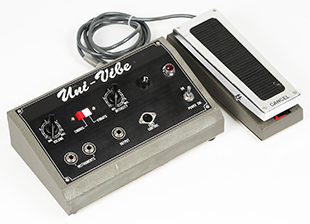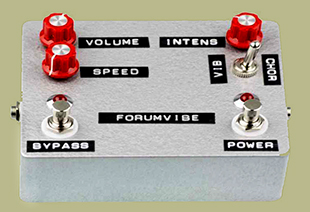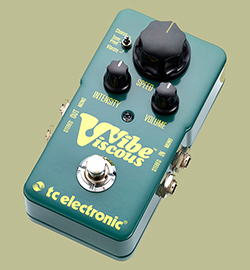![]() With the ambition of the first Leslie emulation pedals finally fulfilled, the story of the Shin-ei Uni-Vibe has come full circle. In its wake we have phasers, flangers and digital modelling pedals, each having taken their shot at replacing the Leslie loudspeaker cabinet and finding their own unique niches.
With the ambition of the first Leslie emulation pedals finally fulfilled, the story of the Shin-ei Uni-Vibe has come full circle. In its wake we have phasers, flangers and digital modelling pedals, each having taken their shot at replacing the Leslie loudspeaker cabinet and finding their own unique niches.
Common sense would have cast the Uni-Vibe aside somewhere along the way. But the final twist in the Uni-Vibe story is its own heritage.
In researching this, I’ve found a surprising amount of misunderstanding surrounding the workings of Leslie cabinets – particularly in younger guitarists’ circles. So let’s take a moment to get this right.
Disappointed by the ability of his Hammond organ to replace a church organ, American inventor Donald Leslie devised a rotating speaker that played on the Doppler effect in an attempt to more accurately mimic the sound of organ pipes.

The concept came to market in the early 1940s in partnership with Hammond – a large, heavy wooden cabinet that housed a rotating drum (with stationary loudspeaker) for the bass frequencies and a spinning horn for the upper range. These are mechanically independent systems, not synchronised in any way, each contributing its own pitch deviations. The speed at which both assemblies rotate can be varied, usually by a single switch offering fast (tremolo), slow (chorale) and stop (brake) settings.
Had it been left to America’s churches, the Leslie story would have followed a very different arc to that injected by jazz organ players and rock organists who discovered and subverted the Hammond/Leslie pairing. The combination of dirty tonewheels, valve distortion and the swirl of a Leslie spoke to them in the same way that solid-bodies, pickups and valves did to guitarists.
This momentum, combined with the sheer size and weight of a Leslie cabinet, spurred Japanese guitar effects manufacturer Shin-ei to develop the original Uni-Vibe (initially released as the Honey Vibra Chorus) in the 1960s as a small, electronic alternative. But a Leslie it was not…
Instead, it was a pedal offering the now familiar Chorus and largely neglected Vibrato settings (Vibrato being the Chorus with the dry signal removed), along with a depth control. There was no onboard speed control, but an optional footpedal was available for managing its sweep rate.
Instead of a Leslie replacement, the Uni-Vibe became a musical endeavour in its own right. Shin-ei produced the Jax Vibra-Chorus and Nomad Verberola with slightly differing internal circuitry, which themselves were re-branded and sold under other names. This early marketing and circuit changes have since played into its intrigue.
The tail end of the 1960s saw the Uni-Vibe at the feet of Jimi Hendrix, most visibly at the Woodstock festival in 1969 (with control pedal) for his controversial rendition of ‘The Star Spangled Banner’. His is one of three guitarists’ names that invariably come up in association with the Uni-Vibe –Pink Floyd’s David Gilmour and Robin Trower following in quick succession. Ahead of the likes of Steve Lukather, Michael Landau, Trey Anastasio and Lenny Kravitz, it was these three who cemented the Uni-Vibe as a ‘reference’ effect.
The most frequently quoted example of Hendrix’s use of the Uni-Vibe is ‘Machine Gun’, from the live Band of Gypsies album released in 1970. For Robin Trower, the signature Vibe track has to be ‘Bridge of Sighs’, although he is a prolific user and it is part of his signature sound. Then there is Pink Floyd’s ‘Breathe’ from Dark Side of the Moon. The problem here is that Alan Parsons, who engineered the album at Abbey Road Studios, makes specific mention of it being a Leslie in a 2012 interview.
What Goes Around…

It’s interesting that a recording made in 1973 and discussed five years ago is still keeping informed listeners guessing about the use of a Uni-Vibe almost 25 years after its release. There was a Uni-Vibe in the pedalboard Gilmour took out to tour DSOTM and also in his first two Pete Cornish boards built in 1976 and 1977. It was absent from the 1980 boards used for The Wall tour, but reappeared as a custom rack unit in 1994 to be used on live performances of 'Breathe' and 'Time'. Whatever the truth of its use on ‘Breathe’, the Shin-ei design team would surely be flattered by the ambiguity.
While, for many, Trower is a suitable heir to the Hendrix legacy, Gilmour’s style and sound are entirely his own. A key element of the Gilmour-era Floyd sound is the use of the Leslie speaker – on organ, guitar, vocals and anywhere it could be made to fit. The Uni-Vibe was never a Leslie replacement, however, but is part of Gilmour’s longstanding experimentation with modulation effects including various phasers and flangers.
Mention of Robin Trower serves to illustrate the next phase of Uni-Vibe history more than its musical influence. Where Gilmour’s Uni-Vibe came from the original stable, Trower stepped into the round of pedals that followed Shin-ei’s innovation. These included models from Dunlop (Jim Dunlop Manufacturing acquired the Uni-Vibe trademark Korg who acquired it though a Univox/Unicord deal), Fulltone’s Deja Vibe (Trower’s chosen Vibe), Roger Mayer’s Voodoo Vibe, Voodoo Labs’ Micro Vibe…
Following the second wave of Uni-Vibe pedals has come endless discussion of the Uni-Vibe circuit itself – a four-stage phaser (as is the MXR Phase 90) with light-sensitive resistors driven by a light bulb and LFO to control the sweep. The filter notches and sweeps were not matched, giving complexities beyond those of a two-stage phaser. The Dunlop Uni-Vibe retains the name but has ventured away from the original circuitry, even abandoning the use of light-dependency, for its own take on the classic character. Other manufacturers have adapted the design too, such as Fulltone’s use of a Vintage/Modern voicing switch – a clever departure from ‘the first exact copy of the 1960s Uni-Vibe’, as it appeared in 1994. Each manufacturer makes a case for theirs being better than the other Vibes on offer.

Then there are the ‘clones’ – kits and circuit descriptions intended to allow home-built pedals to resurrect the classic tone as accurately as possible – such as the Neo-Vibe and Forum-Vibe. There is considerable electronic expertise, access to original units and test gear behind these, and their online documentation is a Uni-Vibe goldmine.
Notes on these clone builds help lift the veil on the secret workings of the Uni-Vibe circuitry. Here is one fan comparing his build to an original: ‘In comparing this unit with my home-brewed clone (based upon the previous Shin-ei unit I borrowed/stole), the fixed component values didn’t seem to be that far off even after 40 years of ageing. Using a 1kHz sine wave as a test signal, it appears the second-stage phaser is “hotter” as is the fourth-stage phaser/vibrato section. This reinforces my hypothesis that the light-sensitive resistors were not matched originally, and have gone through inconsistent ageing, resulting in some units being “sweeter” than others with more pleasant lopsidedness from the beat frequencies.’
Another breaks down the contributory elements of the circuit: ‘It’s built using transistor stages instead of op-amps, with the non-linearity of the transistor stages adding their own magic to the mix. Those strangely mismatched phase shift capacitors mean that differing amounts of phase shift are applied to different frequencies. There are fluctuations in the tolerances of the LDRs and lamp, rather than the matched JFETs that many other more modern phasers use. The strange LFO design (which itself is known as a phase shift oscillator) produces a skewed, non-perfectly symmetrical sine wave which gives the Uni-Vibe that classic "double pulse" sound.’ There is a throrough discussion of the Uni-Vibe ciruitry (here) on the Geo guitar effects website.
Reviving the Vibe
What is inescapable from all of this are the unexpected complexities thrown up by a simple 13-transistor circuit from the 1960s. There are obvious acoustic convolutions and variables that have made the Leslie difficult to emulate, but why the Uni-Vibe? This is compounded by the omission of a Uni-Vibe from Eventide’s ModFactor – and the discussion that surrounds it.
As with the Leslie, one route to putting a convincing and cost-effective Uni-Vibe on your pedalboard is a digital model. Good Leslie models can be found on the likes of Strymon’s Mobius, Eventide’s ModFactor and the Line 6 MM4, along with phasers, flangers, choruses and related effects. The best Leslie models are dedicated pedals, such as Neo Instruments’ Ventilator and Strymon’s Lex. All but the ModFactor also have a Uni-Vibe.
The ModFactor is a powerful processing pedal that delivers impressively on rotary speaker emulations, so why no Vibe? Users have questioned and discussed the omission since the pedal’s release in 2009, prompting one poster – claiming an understanding of both analogue electronics (BSEE by degree) and DSP programming (many years a coder and having managed a team of DSP coders) – to write: ‘My guess is that the R&D team has worked on and/or is working on it, but that the powers that decide what becomes a product have not been happy with the results and that it is still under development.’

Most current Vibe pedals are analogue, including the Vibe-Bro that Shin-ei in the US released in 2016, built using many NOS parts. This list would include the likes of the MXR M68 Uni-Vibe, Moen Vibe’s Shaky Jimi, the Sweet Sound Mo Faux Vibe, EarthQuaker Devices’ The Depths. Interestingly, there is only one dedicated Uni-Vibe modeller – TC Electronic’s Viscous Vibe.
An indication of the complexity presented by a few discrete components can be found in TC’s claim that modelling ‘every single component and every single value of the original circuit with extreme precision’ places a heavy load on the Viscous Vibe’s powerful internal processor. Certainly, the pedal offers the prerequisite Chorus and Vibrato modes, as well as TC’s proprietary TonePrint preset system. It also has a ‘speed ramp’ feature that pushes the sweep rate up when the footswitch is pressed and held, and allows it to fall on release – a nod to the Shin-ei’s use of a footpedal controller.
Today, original Shin-ei Uni-Vibes change hands for thousands of pounds or dollars. My choice is a (secondhand) Fulltone Deja Vibe, as per Robin Trower, although the Strymon model allows some nice additional bass to be dialled in. As the first dedicated Uni-Vibe model, however, the Viscous Vibe represents the current state of the art in DSP footpedal development as well as consolidating the Uni-Vibe’s place in the next stage of stompbox evolution.

